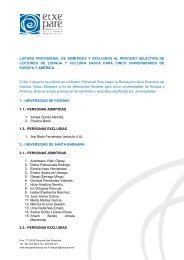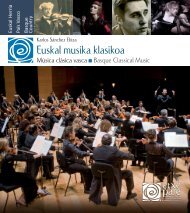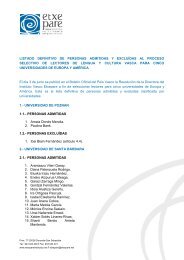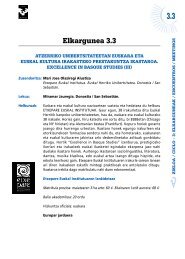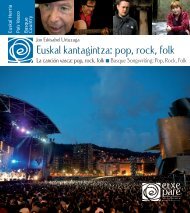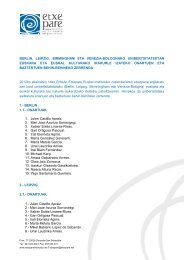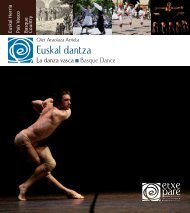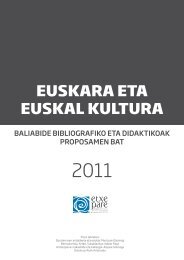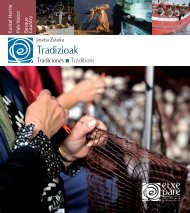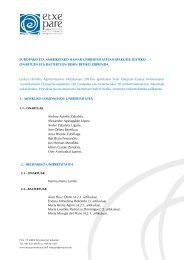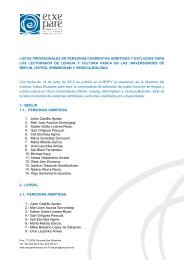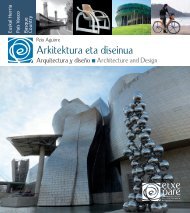XX. mendeko euskal literatura - Etxepare, Euskal Institutua
XX. mendeko euskal literatura - Etxepare, Euskal Institutua
XX. mendeko euskal literatura - Etxepare, Euskal Institutua
Create successful ePaper yourself
Turn your PDF publications into a flip-book with our unique Google optimized e-Paper software.
La obra de Tere Irastortza parte siempre de la experiencia<br />
propia. La poeta trabaja y elabora la palabra,<br />
empeñada en un incesante cuestionamiento y voluntad<br />
de precisión en la expresión, lo cual la ha llevado<br />
en ocasiones a un estricto minimalismo. Entre sus<br />
poemarios figuran Hostoak. Gaia eta gai aldaketak<br />
(1983), Derrotaren fabulak (1986), Osinberdeko<br />
khantoreak (1986) y Manual devotio gabekoa (1994).<br />
Juan Kruz Igerabide es autor de libros poesía para niños<br />
como el conocido Begi-niniaren poemak (1992),<br />
y de interesantes ensayos teóricos en torno a la relación<br />
entre oralidad, poesía e infancia (Bularretik<br />
mintzora, 1993). También ha publicado diversos poemarios<br />
para adultos, entre los que destacan Sarean<br />
lehio (1994) y Mailu isila (2002). Su poesía es breve,<br />
lacónica, cercana al aforismo y a la observación zen.<br />
La <strong>literatura</strong> popular y la espiritualidad oriental zen<br />
y tao constituyen, junto con otras fuentes líricas de<br />
autores vascos o de la <strong>literatura</strong> universal, las referencias<br />
silenciosas de su poesía.<br />
Karlos Linazasoro es el poeta de la soledad extrema,<br />
de la dificultad de identificarse con el colectivo, de la<br />
orfandad del amor y de los afectos y al mismo tiempo<br />
expresión de su necesidad. Es autor, entre otros,<br />
de los poemarios Euriaren eskuak (1995), Kartapazioko<br />
poemak (1998) publicado junto con Igerabide,<br />
Inoiz izan ez garenotan (2000), Eguzkia ateri (2001) y<br />
Denboraren aleak (2005).<br />
Xabier Montoia se dio a conocer con el poemario<br />
Anfetamiña (Susa, 1983). Desde entonces, ha publicado<br />
otros dos poemarios: Likantropo (1985) y Narraztien<br />
mintzoa (1988). La obra del gasteiztarra se<br />
hace eco de la ruptura que planteó Etiopia de Atxaga.<br />
Montoia, cercano al mundo marginal que rodea<br />
al rock, huye de la separación tradicional discriminatoria<br />
entre el lenguaje culto y el subalterno. A nivel<br />
temático, nos muestra espacios urbanos desolados.<br />
Antepone el odio al amor, y su cuerpo se transforma<br />
junto a su espíritu, se convierte en amoral, proclama<br />
la individualidad.<br />
expressive precision, which has on occasion led her<br />
to a strict minimalism. Her books of poetry include<br />
Hostoak. Gaia eta gai aldaketak (1983), Derrotaren<br />
fabulak (1986), Osinberdeko khantoreak (1986) and<br />
Manual devotio gabekoa (1994).<br />
Juan Kruz Igerabide is the author of poetry books<br />
for children like the well-known Begi-niniaren poemak<br />
(1992), and interesting theoretical essays on the<br />
relationship between oral culture, poetry and childhood<br />
(Bularretik mintzora, 1993). He has also published<br />
several books of poems for adults, among which<br />
Sarean lehio (1994) and Mailu isila (2002) stand out.<br />
His poetry is concise, laconic, close to aphorism and<br />
Zen-like observation. Popular literature, Zen and Tao<br />
spirituality, together with other lyrical sources by<br />
Basque authors or from world literature, make up<br />
the quiet sources of his poetry.<br />
Karlos Linazasoro is the poet of extreme solitude,<br />
of the difficulty of identifying with the collective, of<br />
lacking in love and affection and, at the same time,<br />
of the expression of need. He is the author, amongst<br />
other works, of Euriaren eskuak (1995), Kartapazioko<br />
poemak (co-written with Igerabide, 1998), Inoiz izan<br />
ez garenotan (2000), Eguzkia ateri (2001) and Denboraren<br />
aleak (2005).<br />
Xabier Montoia’s first book of poetry was Anfetamiña<br />
(1983). Since then, he ha published two other<br />
poetry works: Likantropo (1985) and Narraztien<br />
mintzoa (1988). Thw work of this writer from Vitoria-<br />
Gasteiz echoes the ground-breaking effect of Atxaga’s<br />
Etiopia. Montoia, who is close to the marginal world<br />
that surrounds rock music, avoids the traditional and<br />
discriminatory division between polite and subaltern<br />
language. As regards his subject-matter, he portrays<br />
desolate urban spaces. He places hate over love, and<br />
his body transforms in line with his spirit, making him<br />
amoral as he proclaims his individuality.<br />
Rikardo Arregi Díaz de Heredia has published two<br />
works of poetry: Hari hauskorrak (1993) and Kartografia<br />
(1998). A cosmopolitan poet who makes use<br />
63



